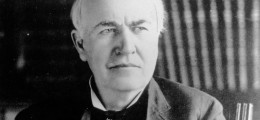“You’ve got to think about big things while you’re doing small things, so that all the small things go in the right direction.” — Alvin Toffler
Robert Krulwich of NPR distilled decades of research in an attempt to answer the question, “why can’t humans walk in a straight line when blindfolded.” For over 80 years, scientist have been baffled by the fact that we seem incapable to walk in a straight line if we don’t have sight of a visible guidepost like the sun, the moon or a mountaintop.
With the help of animator Benjamin Arthur, Krulwich used four experiments conducted in the 1920‘s to illustrate this phenomena:
1. A scientist asks a friend to walk across a field in a straight line, blindfolded…
2. Three men leave a barn on a very foggy day and set out to walk to a point a mile, straight ahead…
3. A blindfolded man is asked to jump in to a lake and swim in a straight line to the other side…
4. A man is asked to drive his car straight across an empty Kansas field…
The curious thing about Krulwich’s examples is that in each case, the subjects walk in a relatively straight line at first but then slowly start to drift. As soon as they start to drift, the curve becomes more pronounced and they quickly begin to walk in circles until many of them end up where they began. In each case, without the ability to see a fixed point in the horizon, people are unable to maintain their original trajectory.
Now I can’t remember the last time I blindfolded myself and tried to walk a straight line across a field, but I have witnessed a similar phenomena when organizations attempt to engage and align teams in continuous improvement. While teams often start out moving in a common direction, without the ability to consistently see a focused and fixed vision of what they are expected to achieve, they quickly start to fall of the path. Like the subjects in Krulwich’s examples, teams begin to go in circles at an increasing rate until many of them are back where they started. What’s worse, is that teams are not just back where they started, they are also now frustrated with leadership because they worked hard to make a positive contribution only to end up confused and demoralized.
A leaders job is to define where the organization needs to go and then empower each team member to accomplish the goals through active problem solving and experimentation. The problem is that merely defining the goal is not enough. To keep the organization from walking in circles, the leader needs to ensure that each team member can consistently 1) see a focused and fixed vision of what they are trying to achieve and 2) design a system that allows everyone to immediately see when they start to deviate from the path. Without clear and consistent goals and the ability to see when they start to drift, leaders, in effect, send their team members across the field blind folded.








What a great visual! It is amazing how everyone still continued to walk around in circles. As a leader, this reiterates the significance of not only having the end goal in sight but to have a system which will allow the team to track how they are doing getting to that goal. Seeing is believing. Thanks for the reminder.
Yes…a clear and fixed goal combined with a management system based on redundant and aligned follow up are the keys. Thanks for the comment.
An interesting phenomenon related to this is that, when asked if a clear vision and goals exist, most leaders will point to statements, banners, websites and myriad other artifacts. What is often missed is the 10, 000 repetitions (communicated in various ways) needed to make the vision and goals real and meaningful. After all, it’s one thing to march blindfolded, yet not much different goose-stepping toward a mirage.
Dave
Dave…Great point. I am working with a couple of organizations on the process of taking very general “vision statements” and turning them into actionable objectives which provide a fixed point for alignment and aggressive action. Thanks for the comment. Mike